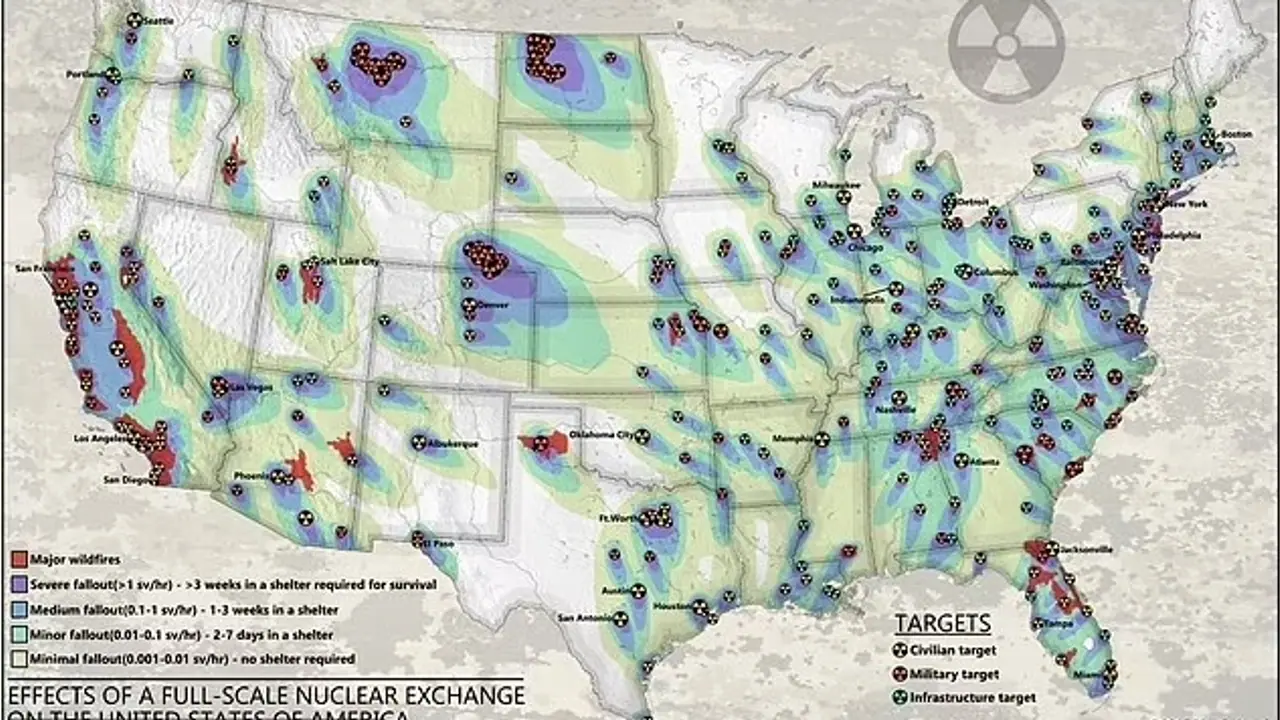The map, based on FEMA’s blast-radius and fallout modeling, paints a harrowing picture: if nuclear war were to erupt, as many as 250 million Americans — roughly 75% of the population — could perish.
Israel launched a sweeping overnight offensive targeting Iran's nuclear infrastructure and missile production hubs — a move that has reignited apocalyptic fears of an impending World War III.

Although the White House remained officially uninvolved in the military action, US President Donald Trump said that Iran had invited this retaliation by defying Western demands to curtail its nuclear ambitions. “Iran had brought the attack on itself by resisting an ultimatum in talks to restrict its nuclear program,” Trump declared.
While Iran is not yet a nuclear-armed state, its powerful allies — Russia and China — collectively possess over 6,000 nuclear warheads. In this tense climate, a chilling map originally designed in 2015 has resurfaced online, graphically illustrating the catastrophic consequences of a full-scale nuclear assault on the United States.
Chilling map reveals where 250m Americans would perish in nuclear attack
The map, based on FEMA’s blast-radius and fallout modeling, paints a harrowing picture: if nuclear war were to erupt, as many as 250 million Americans — roughly 75% of the population — could perish. Major urban centers across the East Coast, Midwest, West Coast, and South stand squarely in the crosshairs. Cities like New York, Los Angeles, Washington D.C., Houston, and Philadelphia would be among the first to face annihilation, given their economic and strategic significance.
The visual data suggests that survivors in affected zones would need to remain in fallout shelters for over three weeks to escape lethal radiation exposure. Areas across California, the Eastern Seaboard, and the Midwest would endure devastating radioactive contamination, while comparatively less impacted regions like West Texas, Nevada, Michigan, and Wisconsin would still grapple with the grim realities of nuclear winter.
“While those who live near military facilities, ICBM silos in the Midwest or submarine bases along the coasts might bear the most immediate and severe consequences of a nuclear attack, there's no question: Any nuclear war or weapons detonation would be bad for everyone. Nowhere is truly 'safe' from fallout and other consequences like contamination of food and water supplies and prolonged radiation exposure,” warned John Erath, Senior Policy Director at the Center for Arms Control and Non-Proliferation.
More than 100 US military installations, particularly those that house Intercontinental Ballistic Missile (ICBM) silos in Montana, Colorado, Wyoming, and North Dakota, are identified as prime targets. The map, which marks high-value locations with red and yellow circles, also highlights the vulnerability of America’s critical infrastructure: power plants, oil refineries, communication hubs, and transportation networks concentrated in Texas, California, and along the Mississippi River.
Israel defended its military blitz on Thursday evening, claiming it had no choice but to neutralize Iran's nuclear threat before it materialized. The airstrikes reportedly decimated over 100 sites, including high-value military and nuclear facilities, and killed several top Iranian military officials.
Trump warns future aggression from Iran would be met with "even more brutal" retaliation
On Friday, Trump raised the stakes further, issuing a grim ultimatum: any future aggression from Iran would be met with "even more brutal" retaliation.
Predictably, Moscow condemned the strikes as “unprovoked” and in direct violation of the United Nations Charter. Russia — which possesses the world’s largest stockpile of nuclear warheads, estimated at 5,580 — has intensified its rhetoric in recent days. China's arsenal, though smaller at approximately 500 to 600 warheads, still looms large on the global stage.
The haunting map from Halcyon Maps, initially created to raise awareness, is once again being circulated as fears of nuclear escalation climb. The map vividly illustrates how radioactive fallout would spread like wildfire across the nation, transforming major cities into uninhabitable danger zones and forcing millions to confront the horrors of radiation sickness — symptoms of which range from nausea and seizures to coma and death, depending on the dosage.
Medium-risk zones, surrounding the core target areas, suggest that even regions not directly struck would endure dire consequences — requiring residents to shelter in place for up to 21 days.
As the military landscape bristles with tension, US defense infrastructure remains on high alert. Strategic targets — including the North American Aerospace Defense Command (NORAD) in Colorado, the Pentagon, and key naval bases in California and Washington — are considered likely candidates in the event of an all-out attack.
Dr. John Schuessler, associate professor of international affairs at Texas A&M University, reflected on America’s delicate position in the evolving global power play. “Americans are not wrong to worry about the United States getting dragged into wars where it is supporting one side against another,” he said. “That said, the US has managed to stay out of the wars in Europe and the Middle East so far.”


